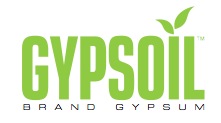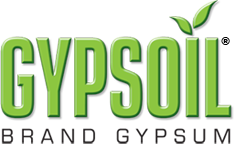News Releases
Media inquiries
Using gypsum to improve soil quality is a popular topic for farm and agricultural inflencer audiences. Please contact our communications consultant Karen Bernick at 1-866-GYPSOIL (497-7645) if you have questions, need story ideas, photos or want to set up interviews with a GYPSOIL team member. GYPSOIL also participates in many national trade shows and meetings including Ag Media Summit, Commodity Classic, National No Tillage Conference and Farm Progress show to name a few.
to improve soil quality is a popular topic for farm and agricultural inflencer audiences. Please contact our communications consultant Karen Bernick at 1-866-GYPSOIL (497-7645) if you have questions, need story ideas, photos or want to set up interviews with a GYPSOIL team member. GYPSOIL also participates in many national trade shows and meetings including Ag Media Summit, Commodity Classic, National No Tillage Conference and Farm Progress show to name a few.
High resolution photos for current news release available here.
Recorded and Powerpoint presentations from the 2014 Midwest Soil Improvement Symposium can be found on the Symposium page.
Highlights from the 2014 press conference at Ohio Farm Science Review.
A collection of general press releases can be found below:
Purdue farm tour attendees learn about gypsum benefits

FOR IMMEDIATE RELEASE
BROWNSBURG, INDIANA - Jack Maloney is the fourth generation of his family to raise crops on his sprawling, lush farm fields here. An early adopter of using technology such as the Global Positioning System to precisely guide his planters and combine, Maloney is an ardent believer in sustaining his farm’s resources, namely the soil. One of the important tools he relies on to help improve soil health and sustainability is Gypsoil™ brand gypsum from Beneficial Reuse Management (BRM).
On June 24, 2010, approximately 250 fellow farmers, university researchers and agriculture industry people gathered at Maloney’s Little Ireland Farm and other area farms as part of the Indiana Farm Management Tour organized by the Purdue Department of Agricultural Economics.
During the tour, Maloney stood on a flat bed trailer in his farm shop to explain how applying one ton per acre of Gypsoil on his fields every other year has made his farm’s silt loam and silty clay loam soils more permeable to rain water, softer down through the soil profile and less prone to surface hardening. He said water does not stand in his fields like it did before he began using gypsum. “I can take two inches of water and it won’t pond,” said Maloney who raises corn, soybeans and seed soybeans using a no-till system. “With gypsum, we have a higher permeability rate.”
Gypsoil is calcium sulfate, a byproduct of the process that cleans the air from coal-burning power utilities by removing sulfur dioxide (SO2) from flue gases. Once applied to soils, Gypsoil neutralizes metals and chemical salts and loosens soil to improve air and water movement throughout the soil profile. It also improves the environment for soil organisms.
Maloney, who farms 2,500 acres, said his soils are more mellow and easier to work, and that he has observed more earthworm activity. The improved biological profile enhances root growth deep into the subsoil, Maloney said. “We’ve had roots down four and half feet.”
Commercial fertilizer use has gone down on the Maloney farm since gypsum started being applied seven years ago. “Our phosphorus and potassium costs are way down because our soil tests tell me not as much is required,” Maloney commented.
Maloney carefully performs soil sampling on half of his farm every year. “I don’t have the peaks and valleys in fertility that I had,” Maloney said.
Comparing results on his fields where gypsum has been applied vs. conventional fields where no gypsum is applied, Maloney said he has calculated a $162/acre savings in input costs assuming customary products and use rates for a comparative conventional field and current market prices for input costs.
| Field with Gypsoil | Conventional Field |
| Phosphate 11-52-0 12.33# or $7.47/acre | Phosphate (11-52-0) 150# or $91 /acre |
| Potassium 0--0-60 21.34# or $10.78/acre | Potassium (0-0-60) 200# or $100/acre |
| Lime: Hi cal 1.3 tons or $25.44/acre | Lime (Any type) 2 tons or $38/acre |
| Gypsoil 1 ton or $23/acre | |
| Results: $66.69/acre | $229/acre |
“We’ve increased yield and lowered costs dramatically,” Maloney said.
The second stop on the June 24th portion of the tour was Starkey Farms, also based here. A 3,000-acre operation that raises corn, soybeans and wheat, Starkey Farms is operated by brothers Mike and Dave Starkey and Dave’s son, Jeff.
Mike Starkey says his background in accounting helped him to prioritize information gathering functions at the farm, including a heavy use of on-farm trials to evaluate the impact of various inputs. “We are not afraid to change things when we find something that works better,” Mike Starkey said in his large modern shop where lunch was later served and Indiana Agriculture Director Joe Kelsay greeted the crowd.
The Starkey family has been a no-till operation since 2000 after trying it briefly in the early 90s but discontinuing the practice when yield went down and stand results were “horrible,” Starkey recalled.
Once he and his family learned how to properly set up planting equipment, place nitrogen efficiently and monitor calcium and magnesium levels in soils, the operation was successful in using no-till, Starkey said. “Our yield stabilized and our input costs and labor went down.“
Starkey echoes Maloney’s comments about water infiltration improvements after using Gypsoil. “It is amazing how water does not stand anymore. When it rains hard, water is just gone now,” said Starkey during a mini tour set up amidst the operation’s planting equipment.
Tile water from both Starkey and Maloney’s farms drain into the Eagle Creek Reservoir which provides drinking water for Indianapolis. Last fall, the Eagle Creek Watershed Alliance, a local water quality study coalition, completed a study monitoring agricultural chemicals, nutrients and sediment entering the reservoir. What they found was that water draining from School branch, the creek that carries water from the Starkey and Maloney farms to the reservoir, had lower agricultural chemical and nutrient levels than other watershed tributaries feeding the reservoir.
The final stop on the Purdue tour was Hession Farms, a 5,000-acre enterprise, also based here, operated by brothers Anthony and Matt Hession, with help from their families, including four college-age sons, and employee Al Good.
The Hessions grow food-grade corn and soybeans and approximately half their crop is corn-on-corn rotation. Anthony Hession said their best yields in 2008 and 2009 were in continuous corn fields. They use variable rate technology for seeding and fertilizer rates based on yield and soil type.
Matt Hession and Good explained the farm’s strip-tilling methods and tillage equipment configurations. They split their nitrogen applications, typically applying a fixed rate at planting and then the balance is applied using variable rate technology as a post-emerge sidedress.
Gypsum has been used on the Hession fields for approximately five years. “We are really starting to see some great benefits,” Matt Hession said.
Ron Chamberlain, director of gypsum programs for BRM, explained how gypsum helps to remediate compaction and other soil structure problems by changing the soil chemistry. He said gypsum improves water infiltration, improves biological systems for better breakdown of residues and ultimately leads to deeper-growing root systems.
“Because gypsum is water soluble, we are seeing changes in the soil four to five feet down into the profile,” Chamberlain said.
Gypsoil was founded in 2006 by Chamberlain and acquired by BRM in 2009. BRM identifies byproducts of various manufacturing processes that can be used in safe and effective ways to benefit land owners and conserve natural resources and preserve landfill space. Created as a byproduct of the eco-friendly process of producing electricity, Gypsoil is an ideal match for BRM.
Jack Maloney (in green), Brownsburg, IN, describes the differences in the root system from a corn plant grown in fields where gypsum has been applied as part of his no-till system versus roots on a corn plant from a conventional field. Assisting is Ron Chamberlain of Gypsoil.
Mike Starkey, Brownsburg, IN, describes his no-till planter set up at the Indiana Farm Management Tour organized by Purdue Department of Agricultural Economics which made a stop at his farm on June 24.
Ron Chamberlain (center) of Gypsoil describes the reasons gypsum helps improve soil structure. He spoke as part of a mini-tour on strip-tilling at Hession Farms that was featured June 24 during the Indiana Farm Management Tour organized by the Purdue Department of Agricultural Economics. Others in photo include (from left): Al Good, Hession Farms employee; and Matt Hession, who operates the farm with his brother, Anthony.




